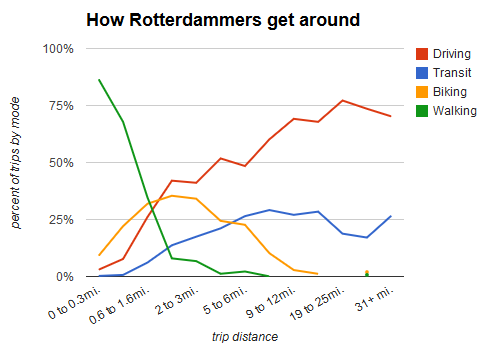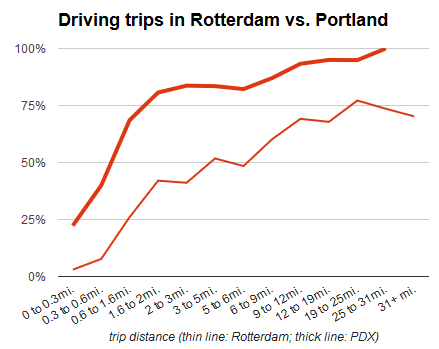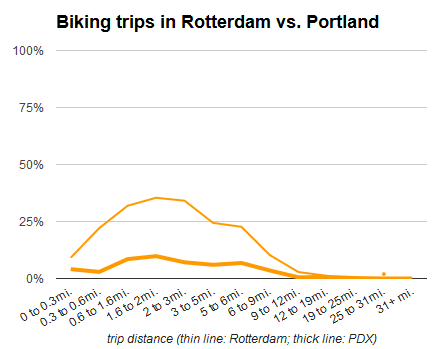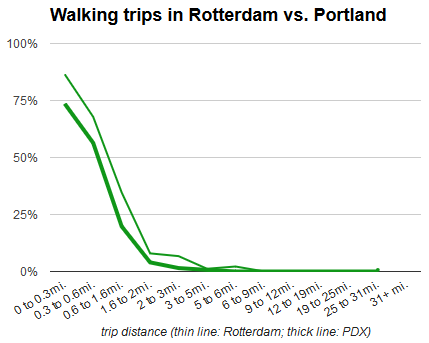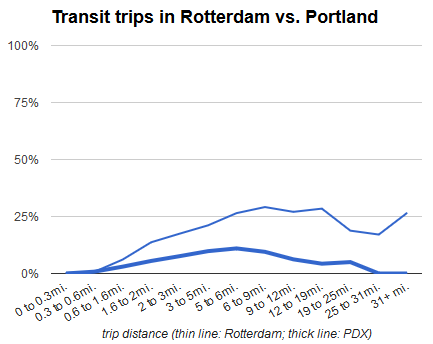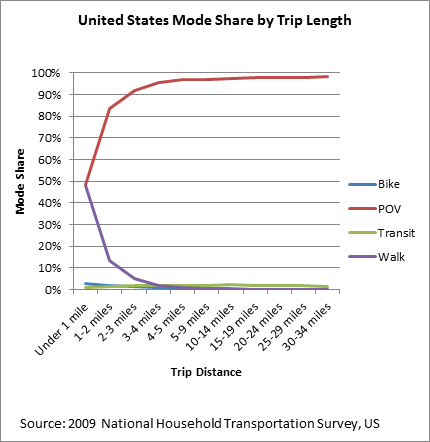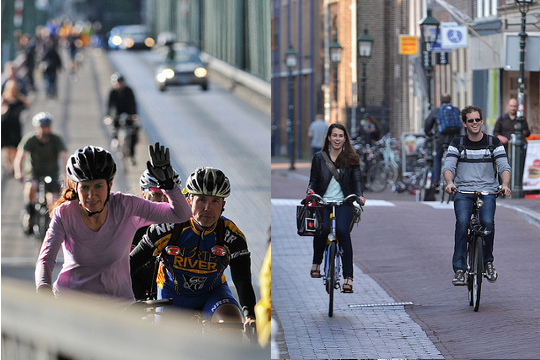
(Photos: J.Maus/BikePortland)
Most city-to-city transportation comparisons are very simple: 64 percent of trips by car, 11 percent by bike, and so on.
But those broad numbers are really just blankets that have been thrown over the intricate topography of transportation choices that’s actually at work in our daily lives. To really understand how cities work, you also have to look at a second factor: How far are people going?
A motherlode of newly released data has revealed those patterns for Portlanders for the first time.
By comparing their answers with the ones given by people in Rotterdam — the Netherlands’ second-largest city, it has almost exactly the population of Portland — we can get a useful look inside the differences and similarities between our country’s bike-friendliest major city and our planet’s bike-friendliest country.
These results draw on an analysis completed last month by Metro staff, based on a local slice of the huge 2011 Oregon Household Activity Survey that asked people to report, trip by trip, the ways they move about their lives. Thanks to some comparative work by Nathan Wilkes, a planner with the City of Austin who’s been comparing Portlanders’ behavior and Dutch behavior to estimate the potential for biking in his city, we can see how we measure up against our friends in Northwestern Europe.
If we chart the distances people travel and the modes they use, here’s what it looks like in Portland:
and in Rotterdam (important caveat: this data includes only work and school commutes):
There’s a lot to see here. Let’s look at these charts piece by piece.
1) Even in the Netherlands, most trips of more than three miles happen in a car.
When you get down to the numbers, the difference in Dutch and Portlander driving habits is big but it really isn’t dramatic. Once trips get to three miles or so, most Rotterdammers start reaching for the car keys, too.
Advertisement
2) The vast majority of Dutch biking comes from short trips.
Rotterdam biking rates peak at about two miles and drop off rapidly over three miles. It’s a pretty clear sign that for all the joys of pedaling, no amount of amazing bike infrastructure can make most people want to take daily bike trips of more than 20 minutes or so. But that’s where the second great gift of dense Dutch cities comes in: almost everything you need is reachable within a 20-minute bike trip. Dutch cities make density affordable by devoting less real estate to front lawns, parking lots, spare bedrooms and one-story buildings.
Another revelation here: though Portlanders’ biking rates also peak around the 2-mile mark (11 percent of those are by bike) they stay fairly steady until they get longer than six miles, at which point Rotterdammers’ biking is seriously tapering off. Maybe that’s because Portlanders who bike a lot are disproportionately athletic. Or maybe we’re just stubborn.
3) Dutch and Portland walking habits are very similar.
Americans are so accustomed to being gloomy about our transportation system that it’s easy to forget: in the parts of our cities that were built before the age of auto-dependent planning, walking is actually pretty good and pretty popular. For trips of less than half a mile, humans generally prefer to walk. They always have and they always will.
4) In the Netherlands, transit is for the long haul.
This chart gives the lie to my least favorite transportation myth: that biking and public transit are competitors. They’re complements. The density that makes Rotterdam great for biking also makes it great for transit, and the whole system works because the abundance of options lets people use the right vehicle for the right job. If you’ve got enough money to spend, it’s possible to create a car-lite city with mass transit alone — see New York or London — but it’s far easier to accomplish if bikes are helping, too.
Another difference sticks out here: commuter trains are a big part of Dutch life. Portlanders start abandoning TriMet when trips get longer than eight miles or so. (That’s about the length of the Yellow Line.) But Rotterdam transit is popular for 30 miles and beyond. It’s no coincidence that commuter rail, with its high speeds and small number of stations, is a particularly good complement to biking.
5) Portland is to most of the United States as the Netherlands is to Portland.
In almost all of the United States, you either drive or you walk.
As a result, nearly half of all U.S. trips of one mile or less happen in a privately operated vehicle. For trips of 2 miles, 90 percent are in cars. Biking and mass transit are negligibly tiny factors in America’s transportation system.
Not every U.S. city is like this, fortunately; six or seven have better public transit than Portland and a few have comparable bike networks. But all these travel figures show that for all the progress we have yet to make in Portland, our choices so far have brought us a long way.
With thanks to Nathan Wilkes at the City of Austin, Lake McTighe at Metro and Roger Geller at the City of Portland.
Correction 6 pm: An earlier version of this post didn’t note that the Rotterdam data comes only from work and school commutes. It’s also worth noting that because these figures already control for distance, that’s a less important factor here than it sometimes is.



